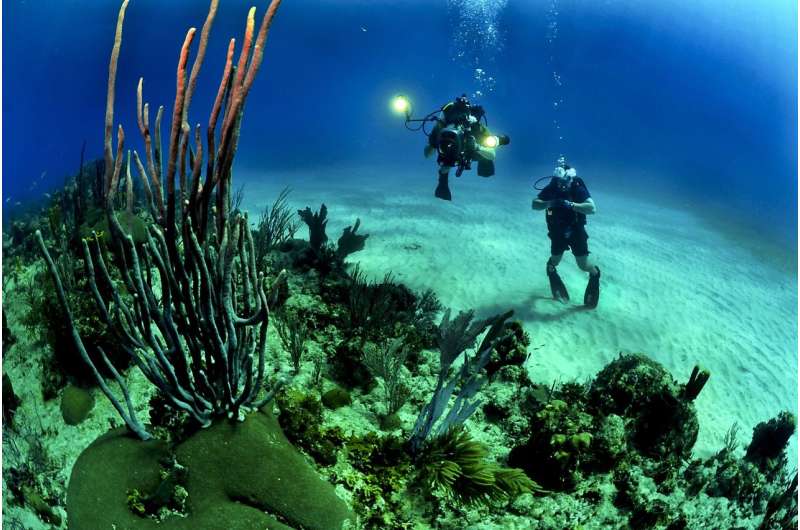Credit: CC0 Public Domain
Acting like high-rise timeshares in the sea, shipwrecks and other artificial reefs can support dense populations of sharks, mackerels, barracudas, jacks and other large migratory marine predators essential to ocean health, according to a new study at 30 sites along the North Carolina coast.
Predator densities were up to five times larger at the 14 artificial reefs surveyed in the study than at the 16 nearby natural reefs that also were surveyed
Shipwrecks, especially those that rose between four and 10 meters up into the water column, were by far the fishes' favorite. At some sites, they supported predator densities up to 11 times larger than natural reefs or low-profile artificial reefs made of concrete.
"These finding tell us two important things. One is that artificial reefs can support large predators, potentially supplementing natural reefs if the design and placement of the artificial reefs are strategic," said Avery Paxton, research associate with the National Oceanic and Atmospheric Administration's National Centers for Coastal Ocean Science (NCCOS) in Beaufort, N.C., who led the study.
"The second thing it tells us is that when it comes to designing artificial reefs, there may be such a thing as a height advantage. We observed more fast-moving predators that live and hunt in the water column at the taller reefs in our study," she said.
Climate change, pollution, development and other stresses have accelerated the decline of natural reef ecosystems across much of the world's oceans in recent years, forcing large predators who formerly fed in the water column around the reefs to venture outside their normal migratory routes and native ranges in search of suitable alternatives.
Because these predators help maintain healthy and sustainable populations of species lower in the food web, providing suitable habitat for them as expediently as possible is critical, said Brian Silliman, Rachel Carson Distinguished Professor of Marine Conservation Biology at Duke University's Nicholas School of the Environment, who collaborated on the study.
"These results highlight that we can strategically use artificial reefs—especially those that are tall—to help counter increasing loss of natural habitat on the ocean bottom," Silliman said.
The scientists published their peer-reviewed study Sept. 2 in the open-access journal PLOS One.
To conduct the study, teams of SCUBA-diving scientists surveyed fish populations at 14 artificial reefs and 16 natural rocky reefs located from 10 to 33 meters deep along a 200-kilometer stretch of North Carolina's continental shelf between 2013 and 2015.
In all, the scientists made 108 separate surveying passes across the artificial reefs and 127 passes across the natural ones. They visited most sites four times a year to track seasonal differences in the number of fish observed, their species and their estimated lengths.
Tall reefs likely draw more large migratory predators because their vertical profiles are easier to spot from a distance, Paxton said. Once there, the fast-moving fish find the added height suits their hunting style by giving them more room to dart in and around the structure and up and down in the water column as they chase prey.
Interestingly, while the scientists observed denser amounts of water-column predators on artificial reefs, they found that bottom-dwelling predators exhibited a different pattern. Large bottom-dwelling predators, like grouper and snapper, tended to be observed in similar densities regardless of reef type. This suggests that artificial reefs can also support bottom-dwelling predators but not nearly to the extent that they support water-column predators.
Following the completion of their own field work, Paxton and Silliman analyzed results from studies at other natural and artificial reef systems around the world and found that the patterns they observed off North Carolina seem to be occurring globally.
"Globally, there is a general pattern where large fish, like sharks, tend to hang out in greater numbers on artificial reefs," Silliman said. "One of many reasons that could underlie this pattern is that tall artificial reefs also attract a lot of bait fish."
These findings suggest that artificial reefs made from—or made to resemble—vessels that have been intentionally sunk could be strategically placed near degraded natural reefs and along migratory routes between those reefs to "act as stepping stones for fish on the move due to climate change or other changes in the ocean," he said.
Since seeing large predators in the wild is a huge tourism draw, these underwater high-rises could also boost coastal economies by creating new destinations for recreational diving, as artificial reefs off North Carolina have already done, he noted.
More information: Avery B. Paxton et al. Artificial habitats host elevated densities of large reef-associated predators, PLOS ONE (2020). DOI: 10.1371/journal.pone.0237374
Journal information: PLoS ONE
Provided by Duke University
























